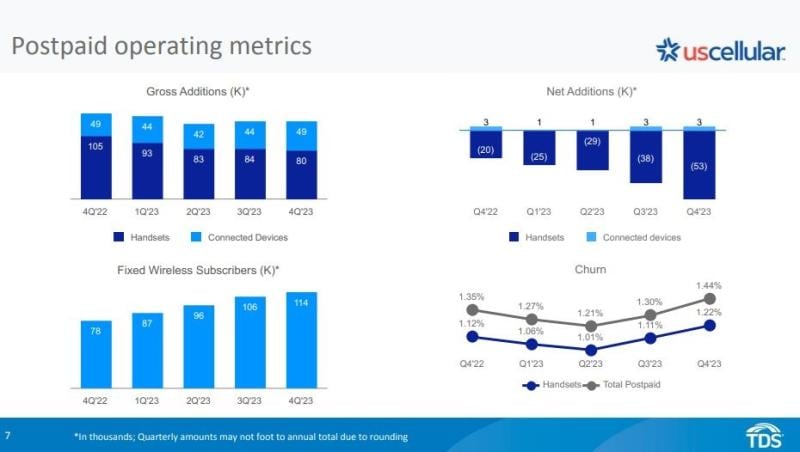The good news is UScellular ended 2023 with 114,000 fixed wireless access (FWA) customers.* The bad news? The company lost about 53,000 postpaid phone customers, exacerbating a string of previous losses.
Besides competing with the Big 3 mobile carriers, UScellular, a regional wireless carrier, is grappling with the rise of cable companies in wireless.
“The thing that has driven the slowdown in gross adds is a pretty simple equation and it’s been the expansion and rise of the cable wireless players,” UScellular President and CEO Laurent Therivel said during today’s earnings call.
A few years ago, cable had essentially zero market share in UScellular’s markets. It now sees cable competing in about two-thirds of its footprint.
And while the wireless market share of the cable companies – led by Comcast and Charter Communications – is still only about 3 to 4%, their share of the gross adds is a lot larger.
Wi-Fi offload
How are the cable companies doing it? Therivel said part of it is tied to their Wi-Fi offload strategies. The cable companies offload almost 90% of their traffic to Wi-Fi, and for UScellular, that figure is more like 80%.
That doesn’t sound like a big difference until you think about it from the perspective of the amount of usage on cellular. Say about 10% of the cable provider’s traffic is on the cellular network, for which they pay Verizon on a wholesale basis. But for UScellular, that means about 20% of its traffic is riding on cellular, or double the amount for cable.
The bottom line is the overall network economics are attractive for the cable operators and they’re able to combine that with profit from their wireline business, he said.
Educated people may debate whether wireless is a profitable business for the cable companies, but “these are smart people and they’re driven by economics” and they wouldn’t be in the business if they weren’t making money, he said.
The big question is how UScellular will turn things around. Therivel said it’s investing in retaining customers, including through aggressive promotions. It’s also expanding its mid-band 5G spectrum deployment, which will result in faster, better service for customers.

Here are some other figures from the earnings:
- UScellular’s postpaid churn was 1.44% in Q4, higher than the 1.3% churn in Q3 2023. Postpaid phone ARPU was $51.51.
- Prepaid net losses, which were flat in Q3 2023, totaled 11,000 in the fourth quarter. Prepaid ARPU was $32.32.
- Tower rental revenues grew 8% to $100 million.
- UScellular reported total operating revenues of $3.906 billion for 2023 compared to $4.169 billion in 2022. Net income was $54 million in 2023 compared to $30 million in 2022.
No word on sale
Telephone & Data Systems (TDS), which owns 83% of UScellular, announced in August that it was exploring “strategic alternatives” for the wireless company.
Company executives declined to comment on the process today except to say that it’s ongoing.
*Editor's Note: This article was corrected to reflect that UScellular ended 2023 with 114,000 FWA customers. It added 8,000 in Q4.